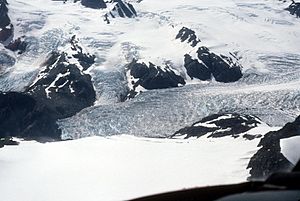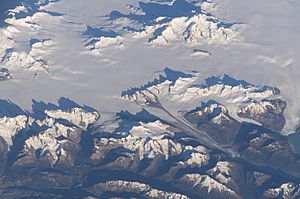Ice field facts for kids

An ice field is a large area where many glaciers are connected. These glaciers are often called mountain glaciers or alpine glaciers. Ice fields are found in mountains where the climate is cold and there's a lot of snow.
Sometimes, the tops of mountains poke out through the ice. These rocky peaks are called nunataks. Ice fields are bigger than a single mountain glacier. But they are smaller than huge ice caps or ice sheets. The shape of an ice field follows the mountains it covers. An ice cap, however, has its own dome-like shape, no matter what the land underneath looks like.
Contents
How Ice Fields Form
Ice fields form when a lot of snow builds up over many years. This snow gets pressed down and freezes, slowly turning into thick ice.
Because ice is affected by gravity, ice fields usually form in large, low areas like basins or on flat mountain tops called plateaus. This allows a continuous sheet of ice to form across the landscape. Glaciers often flow off the edges of ice fields. They act like drains, carrying ice away. New snowfall then replaces the ice that flows away.
An important difference between an ice field and an ice cap is their shape. An ice field's shape is controlled by the mountains around it. An ice cap, on the other hand, is not limited by the land's shape and forms a dome.
Ice Fields Around the World
Asia
You can find several ice fields in the Himalayas and Altay Mountains. These mountains are on the border between parts of Asia and China. There's even an unexpected ice field in Yolyn Am. This is a mountain valley located in the northern part of the Gobi Desert.
Oceania
There are no ice fields in Australia.
However, New Zealand has a few:
- Garden of Eden ice field
- Garden of Allah ice field
- Olivine Ice Plateau
Europe
The biggest ice fields in mainland Europe are in Norway. Examples include the Dovre and Jotunheimen areas. There are also many smaller ice fields in the Alps. Tiny bits of permanent ice can still be found in Sweden, the Apennines, the Pyrenees, and the Balkans.
The southernmost permanent ice field in continental Europe is Snezhnika in Bulgaria. This is because the last ice field in Andalucía, Spain, disappeared in 1913. Outside of mainland Europe, large ice fields exist in Iceland, Svalbard, and Franz Josef Land. Smaller ones are on Jan Mayen and Novaya Zemlya.
North America
One famous ice field in North America is the Columbia Icefield. It's located in the Rocky Mountains between Jasper and Banff, in Alberta, Canada. It's easy to reach by road, making it very popular. However, it's actually quite small compared to other huge ice fields in the region.
Many very large ice fields are found in the Coast Mountains, Alaska Range, and Chugach Mountains. These are in Alaska, British Columbia, and the Yukon Territory. The Stikine Icecap is about 6,500 square kilometers. The Juneau Icefield is about 2,500 square kilometers. Both of these cross the border between British Columbia and Alaska.
Further north, the Kluane Icecap is huge. It feeds massive glaciers like the Malaspina and Hubbard Glacier. It also includes the Bagley Icefield. This ice field sits on the border of British Columbia, the Yukon Territory, and Alaska. It surrounds most of the Saint Elias Mountains, including Mount Saint Elias and Mount Logan. It stretches west all the way to the Copper River.
There are also big ice fields in the Kenai Peninsula and Chugach Mountains area. Examples include the Sargent Icefield and the Harding Icefield. The Alaska Range also has large, mostly unnamed ice fields, including one around Denali, North America's highest peak.
South America
South America has three main ice fields.
The largest is called Campo de Hielo Sur, or the Southern Patagonian Ice Field. It is located in the southern Patagonic Andes mountains. This ice field is shared between Chile and Argentina. It is the second largest continuous ice field outside of the North and South Poles. It covers about 16,800 square kilometers. Only the Kluane / Wrangell–St. Elias / Glacier Bay / Tatshenshini-Alsek Ice Field in southeastern Alaska is larger.
Another important ice field is Campo de Hielo Norte, or the Northern Patagonian Ice Field. This one is entirely within Chile. A third, smaller ice field is known as the Ice Fields of the Darwin Range. It is found on the western (Chilean) part of Tierra del Fuego.
See also
 In Spanish: Campo de hielo para niños
In Spanish: Campo de hielo para niños


